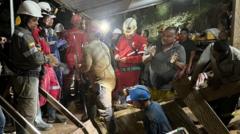Australia has announced the removal of longstanding restrictions that prohibited sexually active gay and bisexual men from donating blood and plasma, marking a significant advancement toward inclusivity and public health. This change comes in line with similar adjustments in the UK and US and will be implemented starting next month.
Australia Ends Discriminatory Blood Donation Restrictions for Gay Men

Australia Ends Discriminatory Blood Donation Restrictions for Gay Men
Australia makes history with an inclusive approach to blood and plasma donation.
The regulations, which originally aimed to reduce HIV transmission through donated blood, will now allow a broader segment of the population to contribute to blood supplies. The national blood donation service, Lifeblood, stated that these revised rules are set to increase the donor pool by an estimated 625,000 individuals.
The decision has been welcomed by health advocates, with Rodney Croome from the Let Us Give campaign declaring that this "overdue and important decision" will save Australian lives. Lifeblood's Chief Medical Officer, Jo Pink, acknowledged the previous policies as a source of stigma for many in the LGBTQIA+ community, affirming that blood safety remains a priority.
Previously, rules prohibited men and transgender women who had sex with men in the prior three months from donating blood or plasma. The new guidelines will permit individuals in a sexual relationship lasting six months or longer with a single partner to donate, regardless of sexual orientation.
Moving forward, questions regarding recent sexual activity will change; donors will be asked about having anal sex with new or multiple partners instead of directly asking men if they have engaged with other men. If the response indicates recent activity, a three-month waiting period will apply before blood donation, though plasma donation will still be possible under those circumstances.
While individuals on the HIV prevention drug PrEP can donate plasma, they are still barred from blood donation if they are still at risk. The only exclusions remaining involve those living with HIV or with a partner with HIV.
The changes, set to take effect on July 14 for plasma donations and anticipated for blood donations by 2026, have been supported by research conducted by Lifeblood in collaboration with the University of New South Wales’ Kirby Institute. This study showed that the new rules will not compromise the safety of the blood supply.
Despite the positive changes, some are calling for even more progressive policies. Sharon Dane of Let Us Give emphasized that Australia's regulations still require more consideration when compared to those in other nations like the UK, Canada, and the US, suggesting these countries have adopted more straightforward guidelines.
As the demand for plasma continues to rise globally, Lifeblood is hopeful that these reforms will enhance supply levels in Australia, ensuring a steadier vein of life-saving donations.
The decision has been welcomed by health advocates, with Rodney Croome from the Let Us Give campaign declaring that this "overdue and important decision" will save Australian lives. Lifeblood's Chief Medical Officer, Jo Pink, acknowledged the previous policies as a source of stigma for many in the LGBTQIA+ community, affirming that blood safety remains a priority.
Previously, rules prohibited men and transgender women who had sex with men in the prior three months from donating blood or plasma. The new guidelines will permit individuals in a sexual relationship lasting six months or longer with a single partner to donate, regardless of sexual orientation.
Moving forward, questions regarding recent sexual activity will change; donors will be asked about having anal sex with new or multiple partners instead of directly asking men if they have engaged with other men. If the response indicates recent activity, a three-month waiting period will apply before blood donation, though plasma donation will still be possible under those circumstances.
While individuals on the HIV prevention drug PrEP can donate plasma, they are still barred from blood donation if they are still at risk. The only exclusions remaining involve those living with HIV or with a partner with HIV.
The changes, set to take effect on July 14 for plasma donations and anticipated for blood donations by 2026, have been supported by research conducted by Lifeblood in collaboration with the University of New South Wales’ Kirby Institute. This study showed that the new rules will not compromise the safety of the blood supply.
Despite the positive changes, some are calling for even more progressive policies. Sharon Dane of Let Us Give emphasized that Australia's regulations still require more consideration when compared to those in other nations like the UK, Canada, and the US, suggesting these countries have adopted more straightforward guidelines.
As the demand for plasma continues to rise globally, Lifeblood is hopeful that these reforms will enhance supply levels in Australia, ensuring a steadier vein of life-saving donations.





















